超级电容器电极材料的研究进展
贾志军,王 俊,王 毅
(1中国科学院过程工程研究所湿法冶金清洁生产技术国家工程实验室,北京 100190;2内蒙古科技大学化学化工学院,内蒙古 包头 014000)
能源是人类社会赖以生存和发展的基础。随着科学技术的进步和社会经济的发展以及生活水平的不断提高,人类对能源需求日益增长。进入新世纪以来,随着石油、天然气和煤等不可再生能源的不断消耗,经济发展与能源供给之间的矛盾明显加剧,并且由于化石燃料燃烧引起的温室效应等环境问题也日益突出,为了改善生态环境,实现社会的可持 续性发展,人类社会的能源供给结构的重心将逐渐向风能、太阳能、潮汐能等清洁和可再生的新能源形式转移[1-5]。但是,可再生能源的不稳定、不连续特性在电能的输送过程中会对电网造成巨大的冲击,影响输电质量,极大地限制了可再生能源的大规模利用。发展高效的储能装置是解决可再生能源发电入网问题的有效途径,被认为是支撑可再生能源发展的战略性技术,得到了各国政府和企业界的广泛关注。
超级电容器,又称电化学电容器,是一种性能介于物理电容器和二次电池之间的新型储能器件 (图 1[6]),兼有物理电容器的功率密度大和二次电池的能量密度高的特点,此外,超级电容器还具有效率高、循环寿命长等显著特点。因此,超级电容器在可再生能源发电并网、电动汽车、信息通讯、航空航天等领域具有广泛的应用前景。特别是在电动汽车技术发展的过程中,人们一直致力于开发高功率密度和高能量密度的超级电容器来作为电动汽车的混合动力系统的一部分。超级电容器可以用来满足汽车在启动、加速、爬坡时的高功率要求,以防护高负载对蓄电池系统的冲击[1]。因此,随着绿色电动汽车技术的发展,超级电容器的研究进入了一个蓬勃发展的新时期。超级电容器主要由集流体、电极、电解质和隔膜等部分组成,如图2所示[7],其中电极材料是影响超级电容器性能和生产成本的关键因素,开发高性能、低成本的电极材料是超级电容器研究工作的主要内容。因此,本文针对目前研究较多的超级电容器电极材料:碳材料、金属氧化物(氢氧化物)、导电聚合物复合材料的最新研究进展进行了简要总结,阐述了这些材料的工作机理、应用前景及价值。

图1 各种电能储存器件的功率密度与能量密度的关系图[6] Fig.1 Relationship between the specific power and specific energy of different electrochemical energy storage devices[6]
1 碳材料
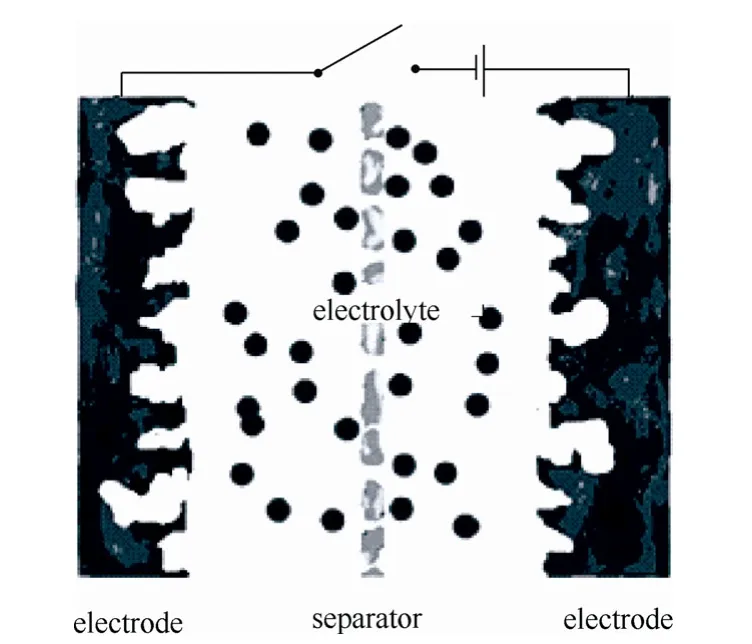
图2 电化学电容器的结构示意图[2] Fig.2 Schematic diagram of an electrochemical capacitor[2]
碳材料是目前用于制造双电层型超级电容器的唯一选择,它主要包括活性炭及活性碳纤维、炭气 凝胶、碳纳米管和石墨烯等。碳材料具有比表面积大、电导率高、润湿性好、电化学窗口宽等优点,能够满足双电层型电容器对电极材料的要求[8-9]。
1.1 活性炭及活性碳纤维
活性炭材料是一种原材料来源广泛、价格低廉、寿命稳定的碳素材料,在商品化超级电容器的生产过程中得到广泛应用。一般认为美国的Sohio公司最先将高比表面积的活性炭材料应用于双电层能量存储装置[10]。活性炭的原料经预处理后进行活化,活化方法分为物理活化法和化学活化法两种[2-8]。物理活化法通常是指在水蒸气、二氧化碳和空气等氧化性气氛中,在700~1200 ℃的高温下,对活性炭原料进行处理[2]。化学活化法是在 400~700 ℃的温度下,采用磷酸、氢氧化钾、氢氧化钠或氯化锌等材料作为活化剂,对原料进行活化[2]。活性炭通常具有较宽的孔分布,包括微孔、介孔和大孔。由于并非所有的孔结构都具有有效的电荷积累,所以比表面积是活性炭电容性能的一个重要参数,但孔分布、孔的形状和结构及表面的官能化修饰等也会影响活性炭的电化学性能。因此,设计具有窄的孔径分布和相互交联的孔道结构、短的离子传输距离以及可控的表面化学性质的活性炭材料,将有助于提高超级电容器的能量密度,同时又不影响功率密度和循环寿命[2-8]。
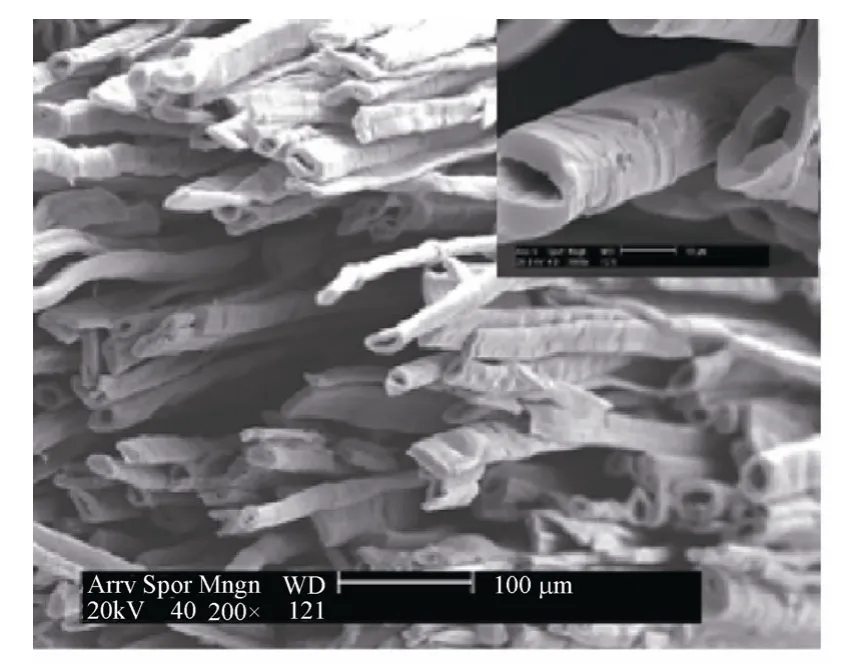
图3 苎麻中空活性碳纤维[14] Fig.3 Hollow active carbon fiber[14]
活性碳纤维(ACF)是在活性炭基础上发展的一种性能优于活性炭的高效活性吸附材料和环保工程材料。ACF具有比表面积大、孔径分布窄、导电性好及比电容高的特点[11-12]。Ma等[13]利用电纺丝 技术制备了微孔碳纳米纤维,在 800 ℃条件下活化,得到ACF,并用KOH调节ACF的直径,当电流密度达到0.2 A/g时,在6 mol/L KOH水溶液中比电容达到了256 F/g。Du等[14]利用苎麻作为原料,在400~750 ℃碳化制备中空ACF,如图3所示,在650 ℃得到性能最好的ACF,当电流密度达到0.05 A/g时,在6 mol/L KOH水溶液中比电容达到了287 F/g。
1.2 炭气凝胶
炭气凝胶是一种具有导电性的气凝胶,具有导电性好、比表面积大、密度变化范围广等特点,是轻质、多孔、非晶态、块体纳米碳材料,其连续的三维网络结构可以在纳米尺度控制,是制备双电层电容器的理想电极材料[15]。
炭气凝胶制备一般可分为三个步骤:形成有机凝胶、超临界干燥和炭化。其中有机凝胶的形成可得到具有三维空间网络状的结构凝胶;超临界干燥可以维持凝胶的结构而把空隙内的溶剂脱除;炭化使得凝胶结构强化,增强其力学性能,并保持有机凝胶的原始结构[15]。
1989年 Pekala利用间苯二酚和甲醛作为反应物,碳酸钠作为催化剂,首次合成出炭气凝胶,研究发现这种炭气凝胶的比表面积为400~800 m2/g,在 5 mol/L KOH 溶液的比电容为 45 F/g,随后关于炭气凝胶的研究逐渐得到关注和重视[16-17]。Wu等[18]利用微乳液模板溶胶-凝胶法制备了炭气凝胶,其比表面积为 586 m2/g,其在 6 mol/L KOH 溶液的比电容为 119 F/g(10 mV/s),相比其它碳材料还有待进一步提高[18]。
目前影响炭气凝胶商业化应用的主要问题是其原材料昂贵、制备工艺复杂、生产周期长、规模化生产难度大。目前炭气凝胶还未能实现产业化,但具有相当广阔的市场应用前景[15-19]。
1.3 碳纳米管
碳纳米管是一种纳米尺寸管状结构的碳材料,具有导电性好、比表面积大、化学稳定性好的优点,可以通过交互缠绕形成纳米尺度的网状结构,因而被认为是高功率超级电容器的理想电极材料[20-26]。Niu等[23]最早报道了将碳纳米管用作超级电容器电极材料的研究工作,他们将多壁碳纳米管制成薄膜电极,在硫酸水溶液中比电容达到49~113 F/g,其功率密度超过了8 kW/kg。但是自由生长的碳纳米管取向杂乱,形态各异,甚至与非晶态炭夹杂伴生,难以纯化,显著影响了其实际应用。近年来,高度有序的结构化、器件化的碳纳米管的制备研究再次引起了人们的关注,这种在集流体上直接生长的碳纳米管阵列,不仅减小了活性物质与集流体间的接触电阻,而且还简化了电极的制备工序。Hse等[27]利用化学气相沉积的方法在碳布上面生长碳纳米管,其结构如图4所示,并将其应用到柔性超级电容器。通过在Na2SO4水溶液中的电化学实验发现,这种生长在碳布上的碳纳米管具有优异的电容性能,电容器工作电压最高可达到2 V,在电流密度为1 A/g时,比电容为210 F/g,并且表现出非常好的稳定性,如图5所示。
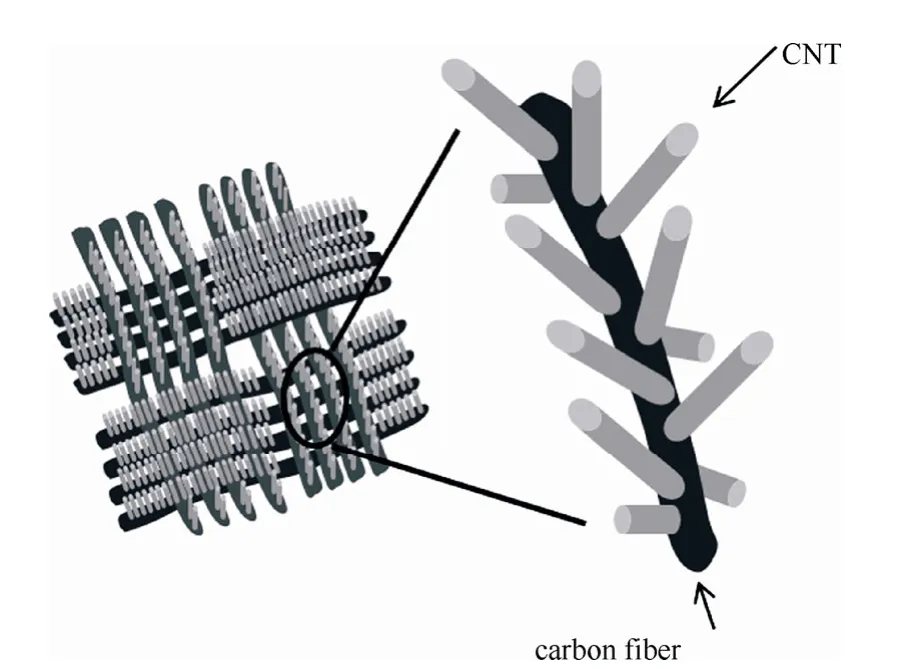
图4 碳布/碳纳米管复合电极结构示意图[27] Fig.4 Diagram of CNTs/CC electrode[27]
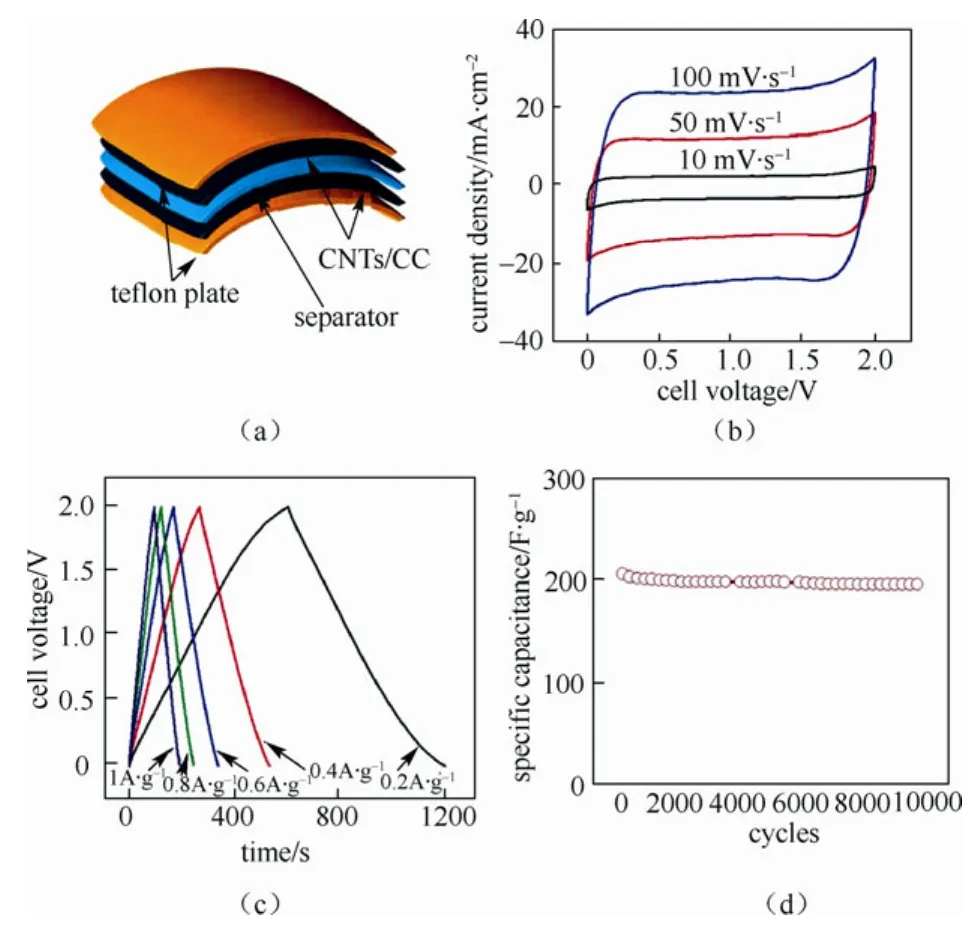
图5 碳布/碳纳米管复合电极电容及其电化学性能[27] Fig.5 Capacitors and electrochemical properties of the CC/CNTs composite electrode[27]
1.4 石墨烯
石墨烯是由碳原子组成的单层石墨片,是已知的最薄的材料之一,而且非常牢固坚硬;作为单质,它在室温下传输电子的速度比已知任何导体都 快[28-30]。碳纳米管和石墨烯分别作为一维和二维纳米材料的代表(图6[31]),两者在结构和性能上具有互补性。相比碳纳米管,石墨烯具有更加优异的特性,如具有高电导率和热导率、高载流子迁移率、自由的电子移动空间、高强度和刚度、高理论比表面积等[31]。因此石墨烯是新型高性能超级电容器电极材料的首选。
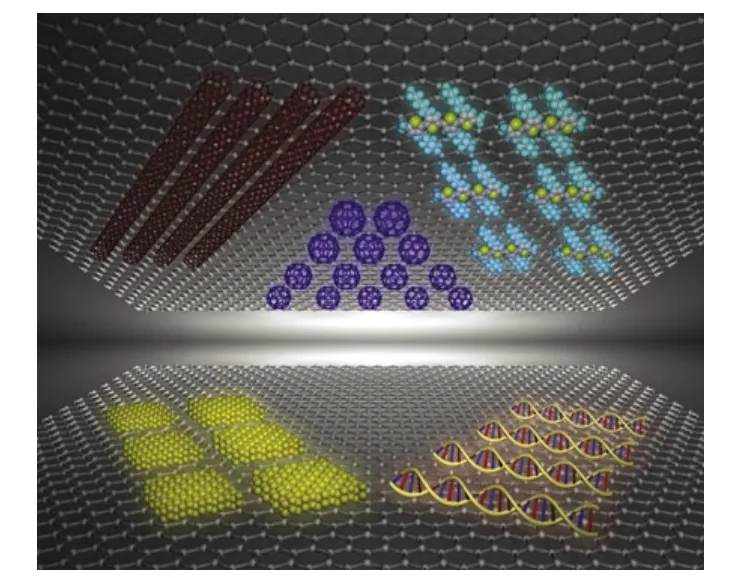
图6 碳材料的结构示意图[31] Fig.6 Structure of the carbon materials[31]
Ruoff研究组最先用水合肼还原法制备出化学改性的石墨烯,并对其电容性能进行了初步的研究,发现这种石墨烯的电导率达到2×102S/m,比表面积也达到了705 m2/g,在水系电解液和无机电解液中的比电容分别为135 F/g和99 F/g,并且具有较高的倍率特性[32]。
Shao等[33]利用聚苯乙烯球作为模板,制备了中空的石墨烯球,其制备工艺如图7所示,并对其电容性能进行了研究,发现这种石墨烯中空球的比表面积达到 440 m2/g,平均孔径为 3.2 nm,在 5 mol/L的 KOH 水溶液中最高比容量达到 273 F/g(0.5 A/g),并具有良好的稳定性。
Lee等[34]利用改性Hummer法和三聚氰胺甲醛树脂表面修饰的方法制备了抗团聚还原氧化石墨烯材料,并对其电容性能进行了研究,发现在不同的充放电电流密度下(0.5~15 A/g),抗团聚还原氧化石墨烯的比容量为150~210 F/g,是普通还原氧化石墨烯的2倍左右[34]。
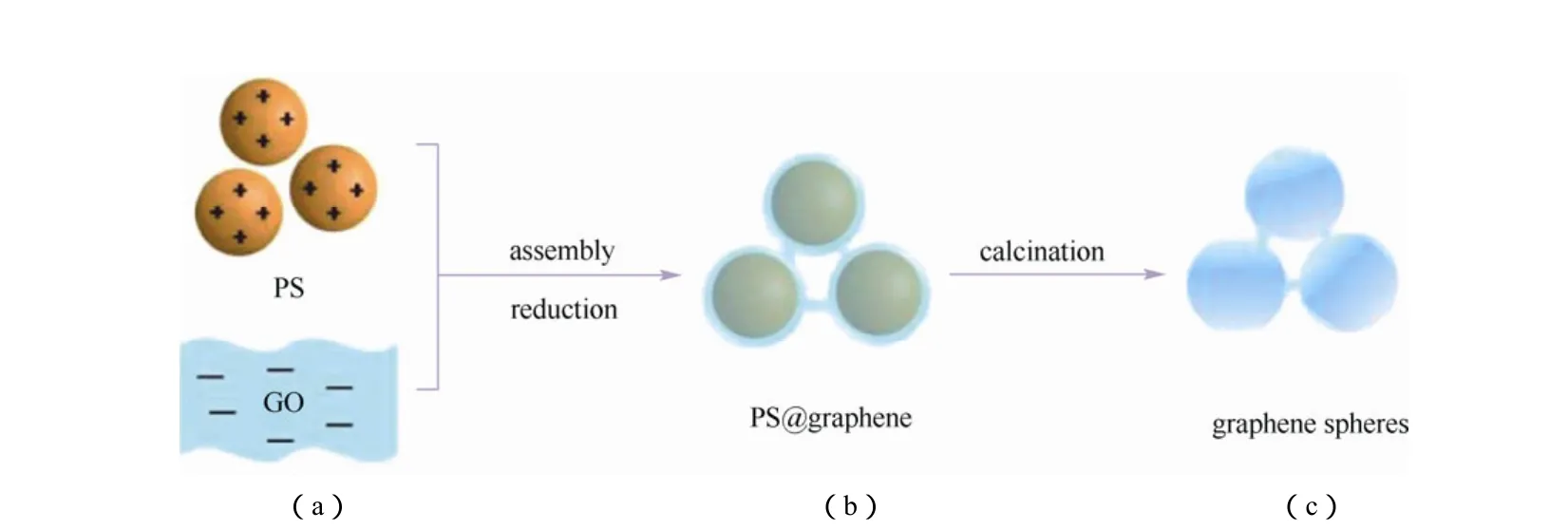
图7 中空石墨烯球的制备工艺[33] Fig.7 Illustration of the preparation process of graphene hollow spheres[33]
2 金属氧化物
金属氧化物是利用电极活性物质在电极表面及近表面快速氧化还原反应存储能量,因此利用金属氧化物作为电极材料的电容器称为法拉第赝电容。法拉第赝电容具有相对较高的比容量,为双电层型电容的10~100倍[35-44]。提高电极活性物质的电化学活性和增大电极活性物质的活性面积,是提高金属氧化物的法拉第赝电容比电容的有效途径。
2.1 氧化钌材料
氧化钌具有比电容大、导电性好、稳定性高等优点,是目前性能最好的法拉第赝电容器的电极材料。早在1995年,美国陆军研究实验室就报道了无定型水合物氧化钌比电容高达768 F/g,基于该电极材料的能量密度为 26.7 W·h/kg[2, 10]。随后的研究工作主要针对氧化钌材料的改性研究。Wu等[45]利用如图 8所示的溶胶凝胶+低温热处理的方法将氧化钌负载到石墨烯表面,借助石墨烯材料的高比表面积和高导电性,以提高活性材料的利用率,研究发现当金属钌的负载量达到 38.2%(质量分数)时,复合材料的比电容约为570 F/g,比电容基本达到与纯氧化钌相当的水平,但能够显著减少钌的用量。目前氧化钌材料应用于航空航天、军事科学等领域,但是钌资源有限,价格十分昂贵,难以普遍应用。
为了进一步提高性能,降低成本,国内外均在积极寻找其它价格较为低廉的金属氧化物电极材料,目前的研究主要集中在二氧化锰、氧化钴、氧化镍、氧化铁和氧化钒等过渡金属氧化物[46-50]。

图8 氧化钌/石墨烯复合材料的制备工艺流程[45]:(a)制备石墨烯;(b)制备石墨烯悬浊液;(c)滴加氯化钌溶液,调节pH至中性;(d)水热法制备氧化钌/石墨烯复合材料 Fig.8 The preparation of ROGSCs by combining a sol-gel method and low-temperature annealing[45]
2.2 二氧化锰材料
二氧化锰是一种常见的金属氧化物,具有价格低廉、环境友好以及电化学窗口宽(在水溶液体系中达到1 V以上)等显著特点。此外,通过纳米材料的可控制备,能够有效提高二氧化锰电极材料的比表面积,提高其电化学性能。
1999年,Goodenough等[51]利用共沉淀法制备了高比表面积的无定形二氧化锰材料,并且研究了无定形二氧化锰电极材料在超级电容器中的应用,这种无定形二氧化锰材料的比表面积为303 m2/g,在2 mol/L的KCl电解液中,比电容达203 F/g[51]。Zhu等[52]采用水热法制备了花朵状二氧化锰纳米颗粒,在中性溶液中,当扫描速率为5 mV/s时,其初始比电容达347 F/g,在循环10000次后,其容量损失只有2.5%,具有良好的稳定性。
2.3 镍、钴氧化物(氢氧化物)
镍、钴氧化物(氢氧化物)是继二氧化锰之后的可作为超级电容器电极材料的金属氧化物(氢氧化物)。这些材料具有来源广泛、制备方法简单、价格低廉等优点,并且具有较宽的电化学窗口,从而能够提高电容器的能量密度和功率密度[53-60]。通过不同的制备技术,可以控制这些材料的形貌,实现电极材料的结构化和纳米化,增大材料比表面积,从而获得更加良好的电化学性能。
Lu等[56]利用电化学沉积法在导电玻璃上沉积了镍钴氧化物,其形貌如图9所示,在1 mol/L KOH电解液中,当循环伏安扫描速率为5 mV/s时,比电容达到 453 F/g。

图9 镍钴氧化物的形貌[56] Fig.9 SEM images of nickel-cobalt oxides nanasheets prepared in a solution by electrochemical deposition method[56]
Xu等[57]利用水热法制备了花朵状的 NiO/ Co3O4金属氧化物复合材料(图10),并且通过控制反应溶液中的Ni/Co比例,调控金属氧化物复合材料中的形貌和电化学性能。
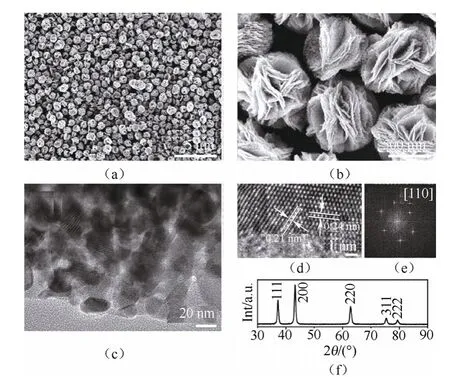
图10 金属氧化物复合材料的形貌[57] Fig.10 The SEM and TEM images of NiO/Co3O4composite[57]
在1 mol/L KOH中的电化学测试,结果如图11所示,发现通过钴的掺杂能够显著提高 NiO电极 材料的比电容;n(Ni)∶n(Co)=3∶2时,NiO/Co3O4金属氧化物复合材料的比电容要大于 n(Ni)∶n(Co)=4∶1时的复合材料。
Liang等[58]利用电沉积和去合金化的方法制备了三维多孔的NiO薄膜,比表面积为264 m2/g,比电容达到1776 F/g。Li等[59]通过水热法在FTO表面直接制备了Ni(OH)2/NiO纳米阵列,比电容为500 F/g。Singh等[60]利用模板电沉积和高温氧化法制备了具有核壳结构的Ni/NiO一维纳米阵列,其最大比容量为1635 F/g,并且在充放电电流密度为15.1 A/g时,能量和功率密度分别达到 49.35 W·h/kg 和7.9 kW/kg。
3 导电聚合物
导电聚合物是一种具有导电性能的高分子材料,主要包括聚苯胺、聚吡咯等,导电聚合物可以通过电极/溶液界面的双电层和其表面发生的快速氧化/还原反应储存能量,因此可以作为法拉第赝电容的电极材料,并且可以通过聚合物的结构设计,优选聚合物的匹配性,提高电容器的整体性能。
Ghenaatian等[61]利用聚吡咯和聚苯胺作为电极材料制备了非对称性超级电容器,采用 1.0 mol/L的KCl水溶液作为电解液,该电容器的电化学窗口为1.3 V,比容量为97 F/g(对所有电极材料),经过1000次充放电循环后仍能保持初始容量的70%,其电极材料的循环伏安曲线及循环性能如图12、图13所示。
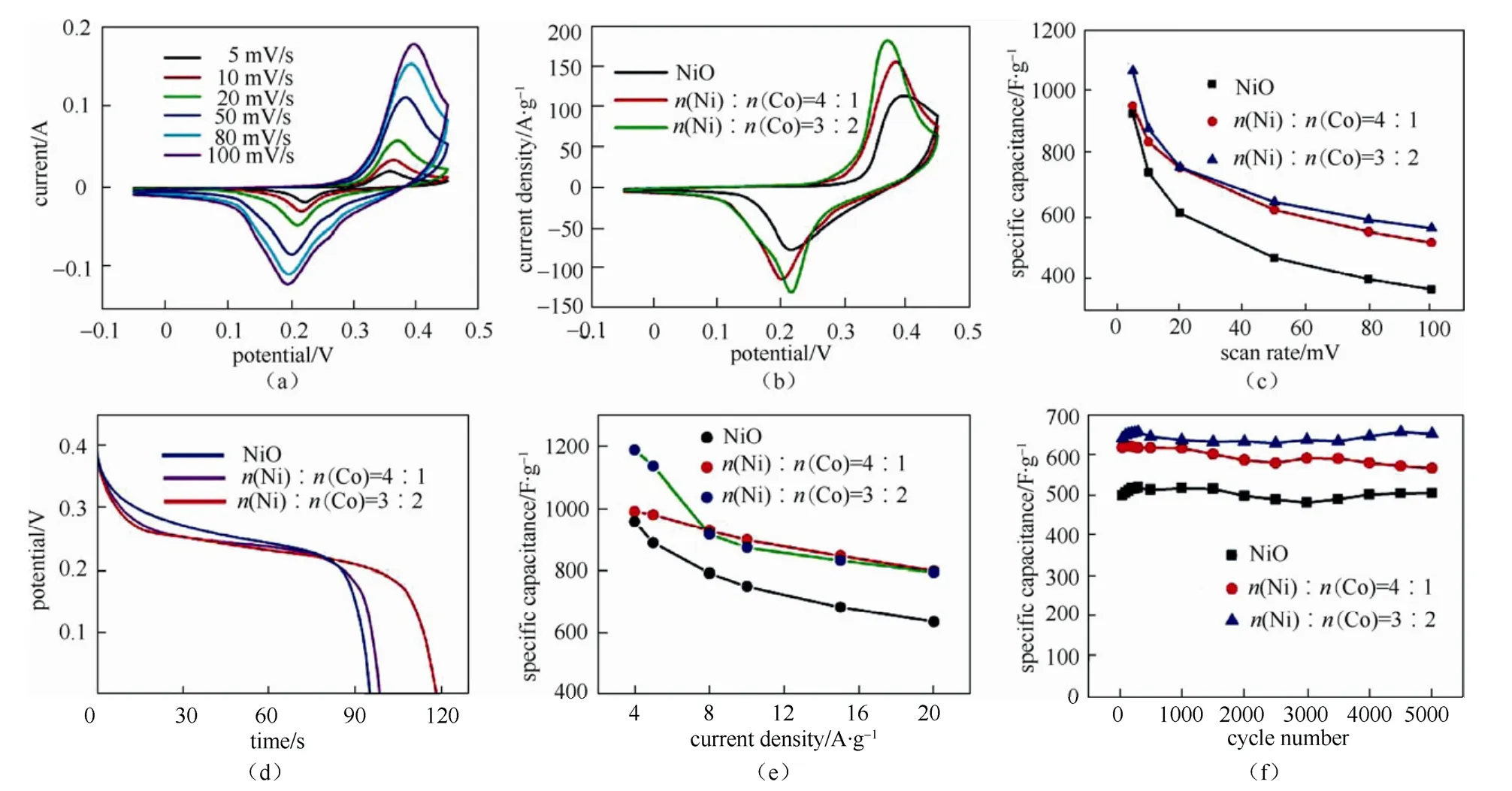
图11 NiO/Co3O4复合材料的电化学测试结果[57] Fig.11 The electrochemical properties of the NiO/Co3O4composite[57]
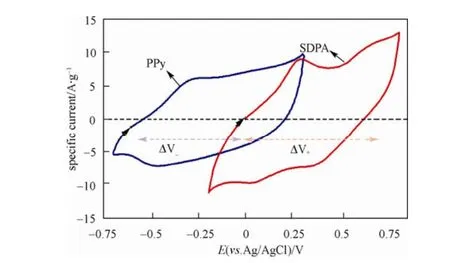
图12 聚吡咯和聚苯胺电极在1 mol/L KCl水溶液中的 循环伏安曲线[61] Fig.12 Comparative cyclic voltammograms of PPA and PANI in a three-electrode system in 1 mol/L KCl aqueous solution at a scanning rate of 20 mV/s[61]

图13 混合电容器的比容量与循环次数的关系 Fig.13 Dependence of the specific capacitance of the hybrid PPy/PANI supercapacitor on cycle number at a charge-discharge current density of 5 mA/cm2
Dhawale等[62]利用化学法和电化学方法[63]合成了纳米结构的聚苯胺,并在1 mol/L H2SO4水溶液中对其电容性能进行了研究,发现其比电容分别为503 F/g和839 F/g,表明电化学沉积法制备的聚苯胺的多孔结构能够提高其比电容。
4 复合材料
复合材料作为一种新型的超级电容器的电极材料是近年来的研究热点,其主要特点是利用各组分之间的协同效应提高超级电容器的综合性能。超级电容器复合电极材料主要包括碳/金属氧化物复合材料,碳/导电聚合物复合材料以及金属氧化物/导电聚合物复合材料等。
4.1 碳/金属氧化物复合材料
4.1.1 碳纳米管(CNT)复合材料
Zhao等[64]利用水热法合成了α-Fe2O3纳米球,并且利用如图 14所示的喷涂-沉积技术制备了CNT-Fe2O3复合材料,将其作为超级电容器的正极材料。在 LiClO4-碳酸次乙酯(EC)-碳酸二甲酯(DMC)电解液中,当电位扫描速率为2 mV/s时,通过循环伏安曲线计算该复合材料的比电容为 100 F/g,相比CNT和α-Fe2O3的比电容均有较大幅度的提高,其原因为:① CNT能够改善α-Fe2O3的导电性;② α-Fe2O3能够与Li+反应,提高复合材料的比电容,其反应机理如式(1)~式(3)所示。

其中式(1)和式(2)发生在第一次充电过程中,以后的每次充放电都遵循式(3)进行。

图14 喷涂-沉积制备方法的示意图[64] Fig.14 Spray-deposit method for CNT-Fe2O3composite fabrication[64]
Chen等[65]利用直接水热的方法制备了 CNT- Ni(OH)2复合材料,由图15可以发现,CNT均匀地分散在Ni(OH)2颗粒之中。通过在6 mol/L KOH溶液中的电化学测试可知,在充电电流为5 A/g时,复合材料的比电容为 1244.2 F/g;而当充放电流密 度为 20 A/g时,比电容仍保持在 771.3 F/g,较Ni(OH)2颗粒(372.1 F/g)和 CNT(101.4 F/g)有显著提高。
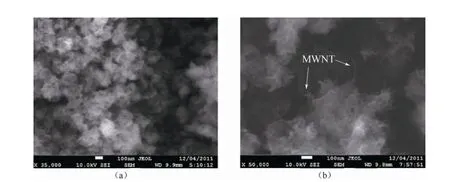
图15 纳米Ni(OH)2与CNT-Ni(OH)2复合材料的形貌[65] Fig.15 SEM images of the Ni(OH)2and CNT-Ni(OH)2composite[65]
基于其高比表面积、高化学稳定性的特征,碳纳米管作为支撑材料得到了迅速地发展。碳纳米管/金属氧化物(氢氧化物)复合材料作为超级电容器电极材料也得到了广泛地关注,并且显著地提高了超级电容器的比容量,但是由于复合方法的不同,电极材料的比容量差异较大,见表 1。随着研究的不断深入,复合材料制备方法将会进一步完善,碳纳米管/金属氧化物(氢氧化物)复合材料将会在高比容量、高比能量密度的超级电容器中得到广泛 应用。
4.1.2 石墨烯复合材料
Lee等[71]利用水热合成的方法在石墨烯上负载 了Mn3O4纳米针,如图16所示。在1 mol/L Na2SO4电解液中,当充放电电流密度为0.5、1、2、5、10、15和20 A/g时,基于复合材料质量的比电容分别为121、115、107、97、88、85 和 83 F/g(电位窗口为–0.1~0.7 V),经过 10000次充放电循环后(5 A/g),其容量保持率接近100%。通过与纳米Mn3O4电极的对比,发现石墨烯/Mn3O4复合材料的比电容 显著增大,表明借助于石墨烯的导电性,可以降低电极材料的内电阻,减小电化学极化的影响;并且石墨烯的高比表面积也提高了Mn3O4的利用率,从而使复合材料的比电容增大。
Ghosh等[72]利用水热的方法制备了CTAB修饰的 Co(OH)2/石墨烯复合材料,其制备过程如图 17所示。利用这种方法制备的Co(OH)2具有六边形的层片状结构,如图18所示。

表1 各种碳纳米管/金属氧化物复合材料的电容性能比较 Table 1 The property comparison of some CNT/metal oxide composite
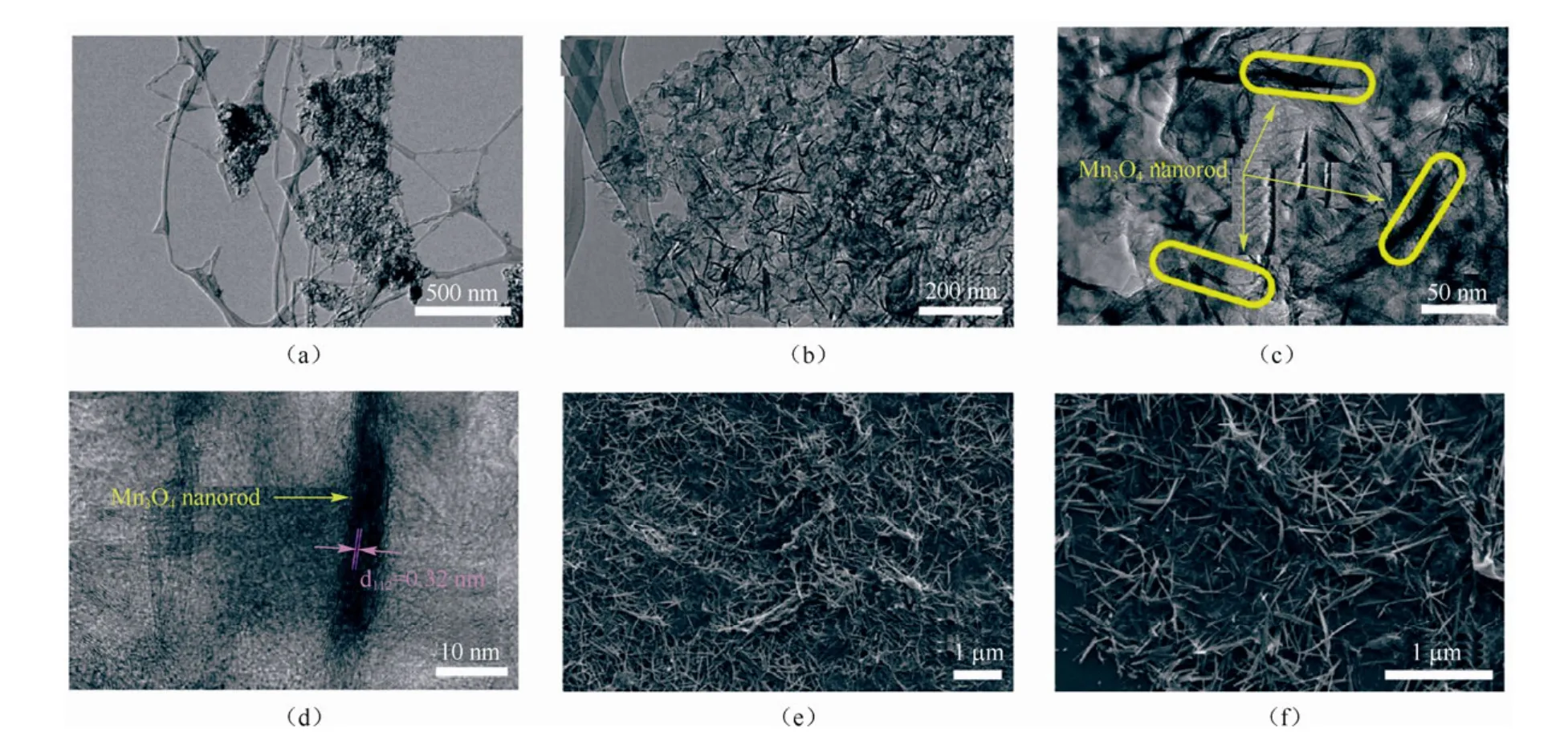
图16 石墨烯/Mn3O4复合材料的透射电镜和扫描电镜照片[71] Fig.16 The TEM and SEM images of the graphene /Mn3O4composite[71]
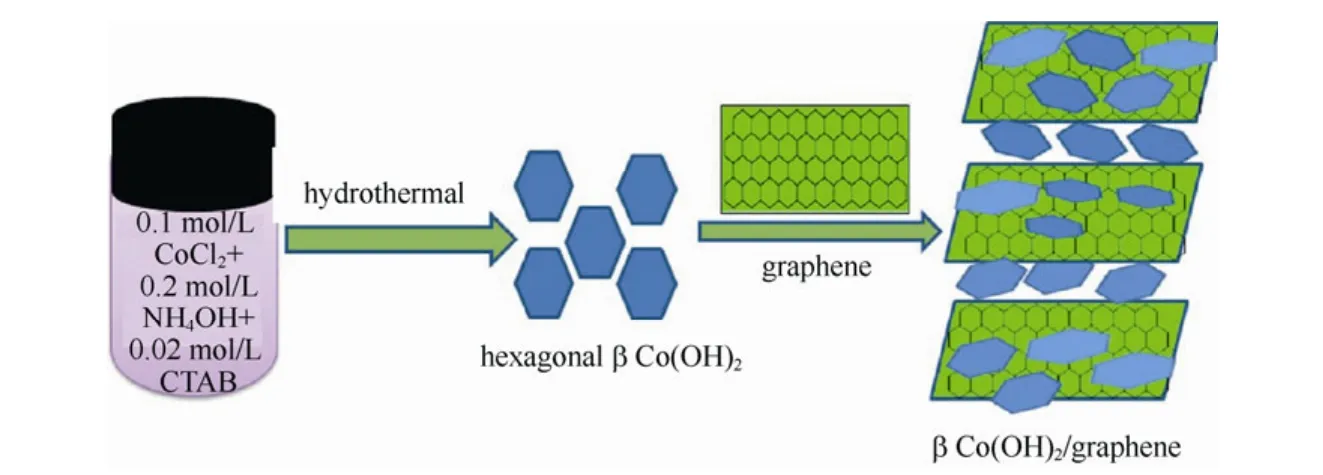
图17 CTAB修饰的Co(OH)2/石墨烯复合材料制备过程示意图[72] Fig.17 The fabrication process of the CTAB decorated Co(OH)2/grapheme composite[72]

图18 CTAB修饰的Co(OH)2/石墨烯复合材料电镜图[72]:(a)无CTAB修饰Co(OH)2;(b)0.01 mol/L CTAB修饰的Co(OH)2;(c)0.02 mol/L CTAB 修饰的 Co(OH)2;(d)CTAB-Co(OH)2/石墨烯复合材料[72] Fig.18 The images of CTAB decorated Co(OH)2/grapheme composite[72]
利用循环伏安法评价了无 CTAB修饰的Co(OH)2的电化学性能,发现当扫描速率为2 mV/s时,其最大比容量为312 F/g;通过恒流充放电实验发现,当电流密度为 2 A/g,该材料的最大容量为285 F/g。通过与石墨烯复合后,CTAB-Co(OH)2/石墨烯电极在电流密度为 2 A/g时的比容量为 532 F/g,约为复合前的2倍,并且在循环500次后,容量保有率仍保持在94%以上(图19),表明石墨烯不仅能够提高Co(OH)2的电容特性,而且还能够改善电极材料的稳定性。
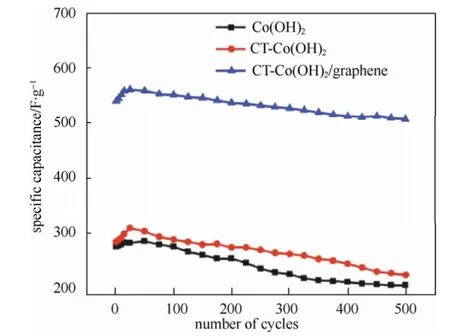
图19 不同Co(OH)2材料及Co(OH)2/石墨烯复合材料电容特性[72] Fig.19 The capacites of the Co(OH)2/grapheme composite[72]
石墨烯/金属氧化物(氢氧化物)是目前超级电容器电极材料研究的热点,负载金属氧化物的种类 繁多,见表2,电极材料的比电容得到了显著提高。随着研究的不断深入,新型石墨烯/金属氧化物复合材料在高性能超级电容器电极材料中将会得到广泛的应用。
4.2 碳/导电聚合物复合材料
Ge等[85]利用如图20所示的方法制备了碳纳米管/聚苯胺透明复合材料,并将其作为超级电容器材料进行了测试。测试结果如图21所示。当聚苯胺的质量分数为59%、充放电电流密度为2.6 A/g时,电容器的比容量达到55 F/g,电极材料的比容量达到234 F/g,但是该电容器的稳定性较差,充放电循环500次后,电容器的库仑效率下降到20%左右,其原因主要是由于电极材料与集流体的接触问题,而并非电极材料造成的。因此证明了碳纳米管/聚苯胺透明复合材料可以作为柔性电容器的电极材料应用。

图20 碳纳米管/PANI复合材料的制备流程[85] Fig.20 The fabrication process of CNT/PANI composite[85]
Liu等[86]利用原位聚合的方法制备了三维石墨烯/聚苯胺复合材料,并在3 mol/L KOH中测试了其电容性能。通过充放电测试发现(图 22),三维石墨烯/聚苯胺复合材料的比容量较之三维石墨烯和聚苯胺均有较大幅度的提高(220 F/g),其原因主要是三维石墨烯的导电性和比表面积较大,提高了聚苯胺的利用率,并且三维石墨烯本身也具有较大的比容量。该材料具有较好的稳定性,在充放电循环500次后,其比容量仍保持在175 F/g以上。
随着导电聚合物材料的不断发展,碳/导电聚合物复合材料的研究将会呈现更加丰富的内容,是超级电容器电极材料的重要研究方向,但目前仍处于研究阶段,离商业化的目标还有很长一段路要走。
4.3 金属氧化物/导电聚合物复合材料
Sumboja等[87]利用二氧化锰作为轴心制备了同轴的聚苯胺(PANI)纳米线(图23),并在1 mol/L Na2SO4测试了其电容特性。利用这种方法制备的 MnO2/PANI同轴纳米线的形貌如图24所示,由图可以发现,PANI均匀地包覆在MnO2纳米线的表面,通过EDS的结果可以证明MnO2纳米线仍然保留在 PANI纳米线中,形成了MnO2/PANI同轴纳米线。

表2 各种石墨烯/金属氧化物复合材料的电容性能比较 Table 2 The capacities comparison of some grapheme/metal oxide (hydroxied) composites
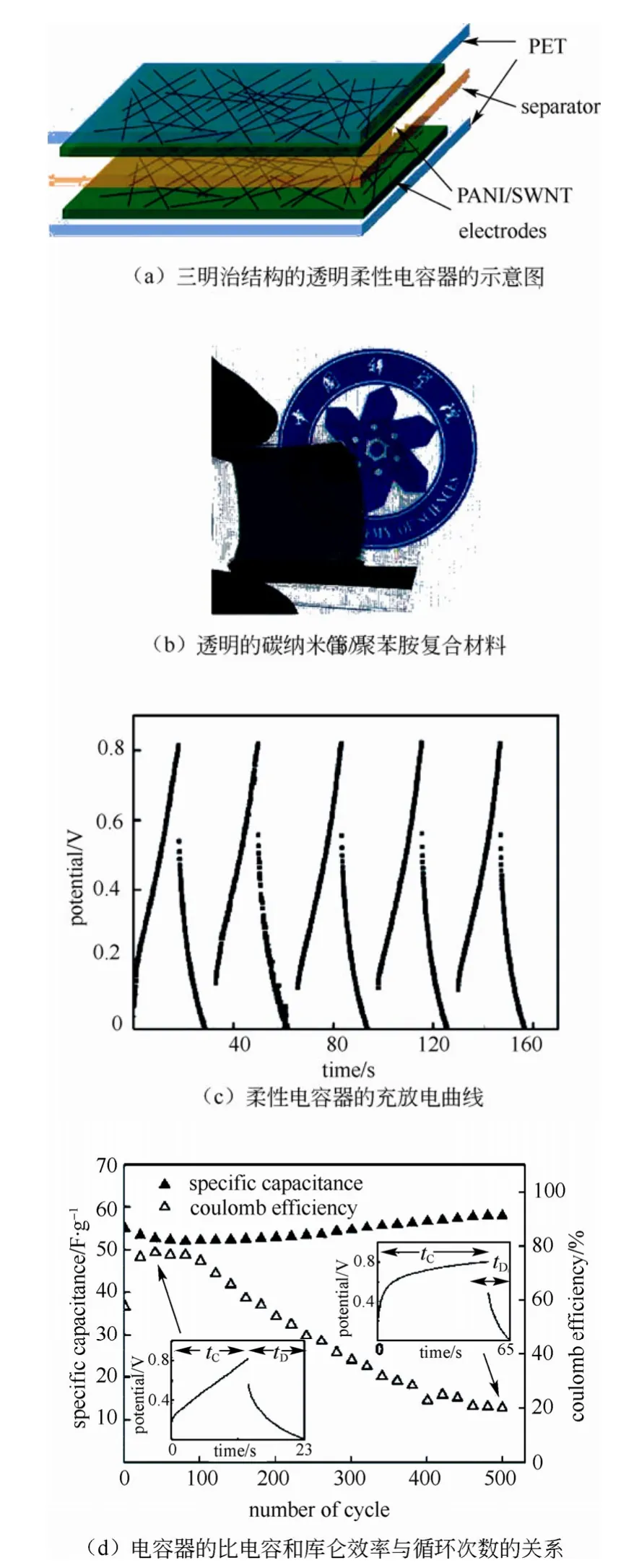
图21 透明柔性电容的结构及其电化学性能[85] Fig.21 Structure and electrochemical properties of the supercapacitor[85]
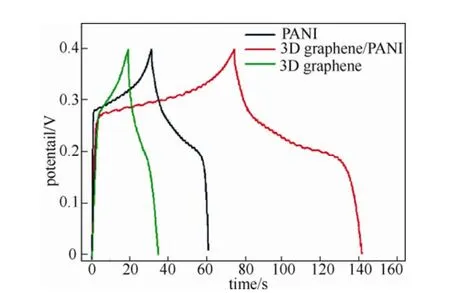
图22 三维石墨烯/聚苯胺复合材料以及三维石墨烯、聚苯胺等材料的充放电曲线[86] Fig.22 The Charging and discharging curves of 3D grapheme/PANI composite, 3D grapheme and PANI[86]

图23 同轴MnO2/PANI纳米线的制备流程图[87] Fig.23 The fabrication process of MnO2/PANI composite[87]
通过电化学测试结果发现,如图25所示,MnO2/ ANI同轴纳米线与 MnO2纳米线和 PANI相比 具有更大的比电容,当充电电流密度为 0.25 A/g 时,MnO2/PANI同轴纳米线的比电容达到873 F/g,随着充放电电流密度的增大,虽然比电容迅速下降,但在电流密度为30 A/g时,仍保持在250 F/g左右,表明MnO2/PANI同轴纳米线具有较好的倍率性能。在 MnO2纳米线表面包覆 PANI材料,能够改善MnO2的导电性,而且PANI作为电容器的电极材料 也表现出较好的赝电容特点,所以MnO2/PANI同轴纳米线具有高的比电容,并表现出较好的倍率性能。
Zhou等[88]利用水热方法在泡沫镍上面包覆一层纳米 CoO,并且利用化学浸泡法在纳米 CoO表面锚固一层导电聚吡咯,形成三维CoO/聚吡咯复合材料。根据在3 mol/L KOH溶液中的电化学实验结果,如图 26所示,发现在 CoO 表面复合聚吡咯 能够显著提高 CoO材料的比电容,其比电容达到2223 F/g,接近CoO比电容的2倍,并具有良好的稳定性。
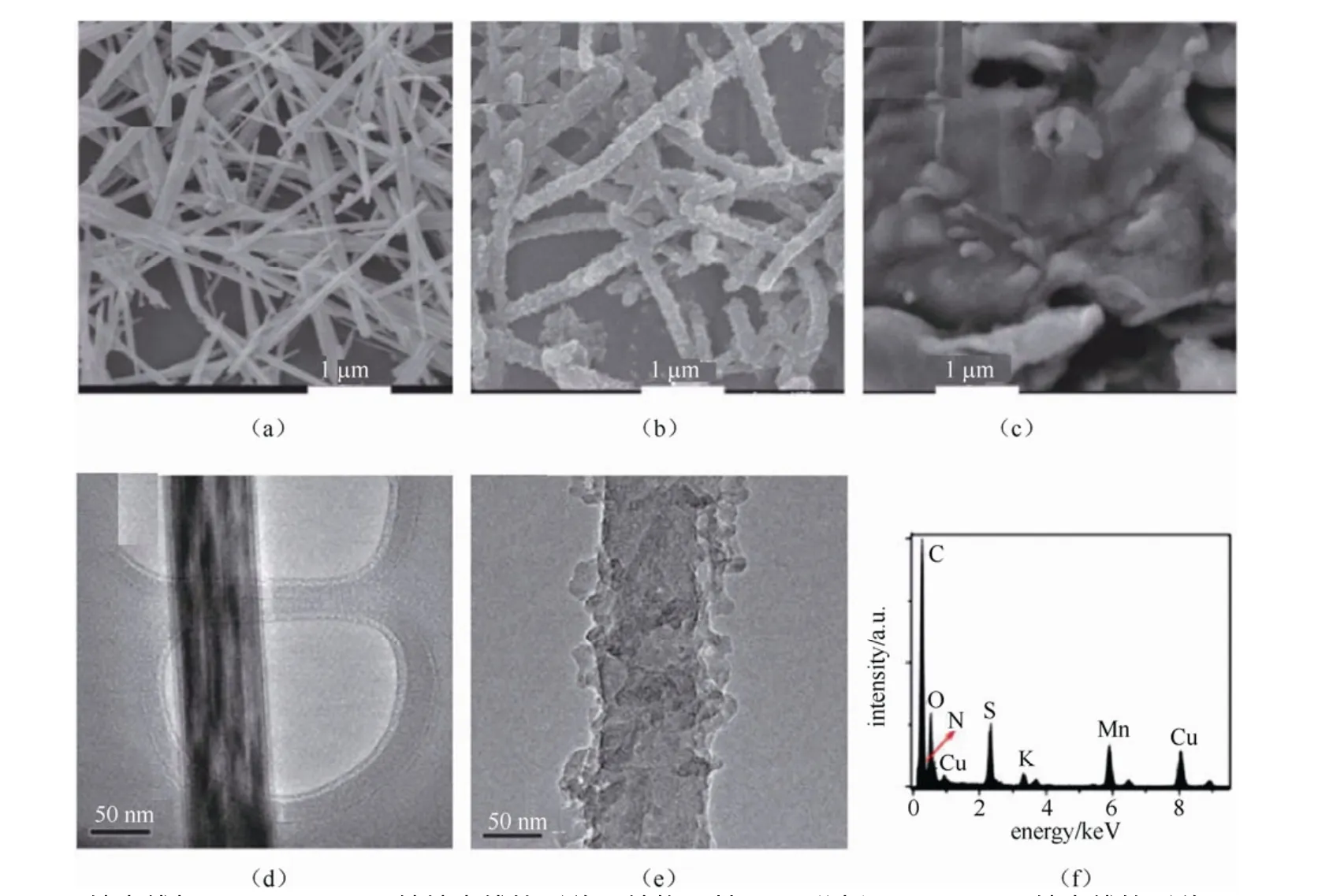
图24 MnO2纳米线与MnO2/PANI同轴纳米线的形貌、结构及其EDS分析:(a)MnO2纳米线的形貌(SEM);(b)MnO2/PANI同轴纳米线形貌(SEM);(c)PANI形貌(SEM);(d)MnO2纳米线的形貌(TEM);(e)MnO2/PANI同轴纳米线形貌(TEM);(f)MnO2/PANI同轴纳米线EDS结构[87] Fig.24 The SEM and TEM images of the MnO2/PANI composite, MnO2nanowire and PANI nanowire[87]
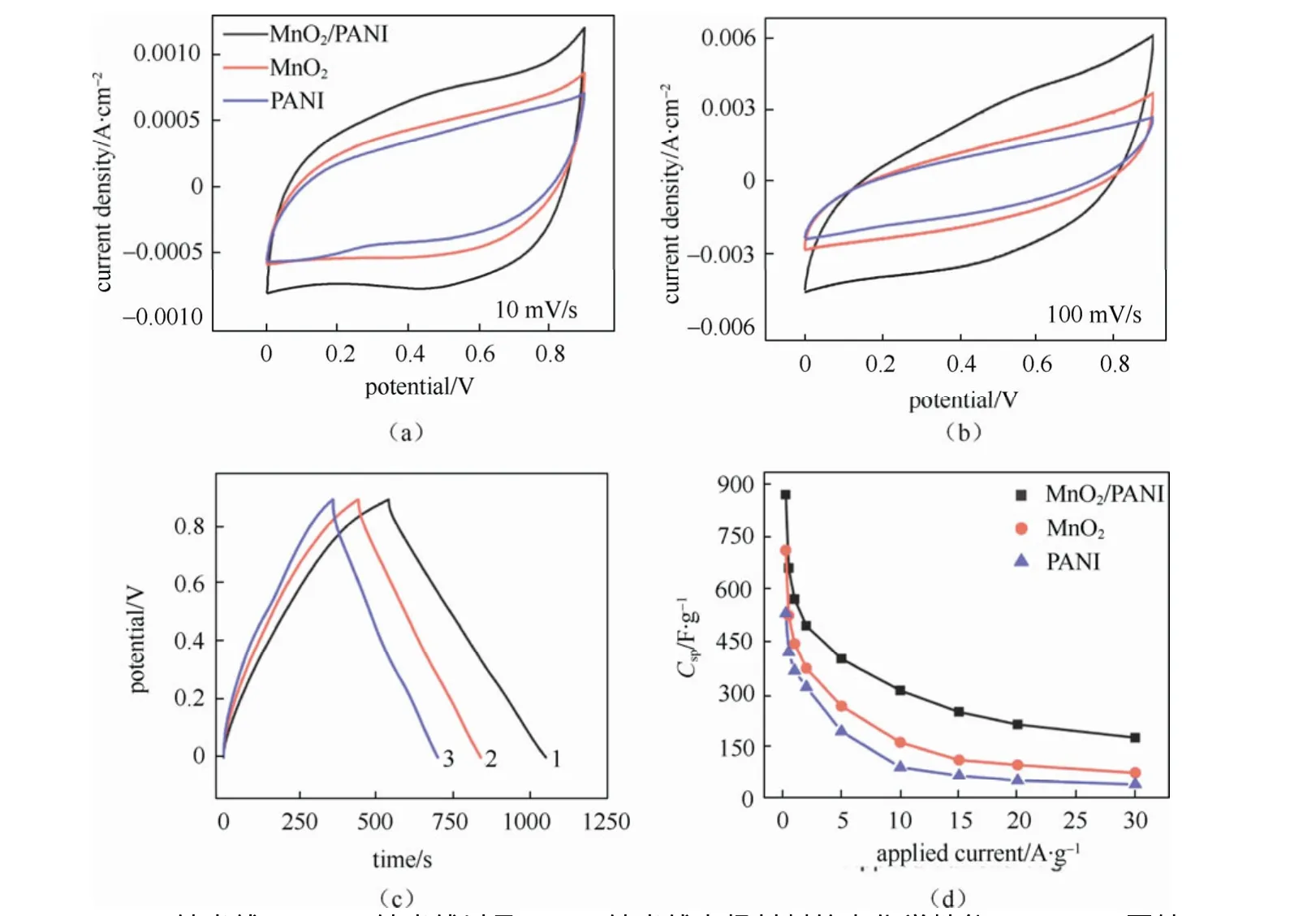
图25 同轴MnO2/PANI纳米线、MnO2纳米线以及PANI纳米线电极材料的电化学性能:(a~b)同轴MnO2/PANI纳米线、MnO2纳米线以及PANI纳米线电极材料循环伏安曲线(10 mV/s,100 mV/s);(c)不同电极材料的充放电曲线;(d)不同电极材料的比电容与电流密度的关系[87] Fig.25 The electrochemical properties of the MnO2/PANI composite, MnO2nanowire and PANI nanowire[87]
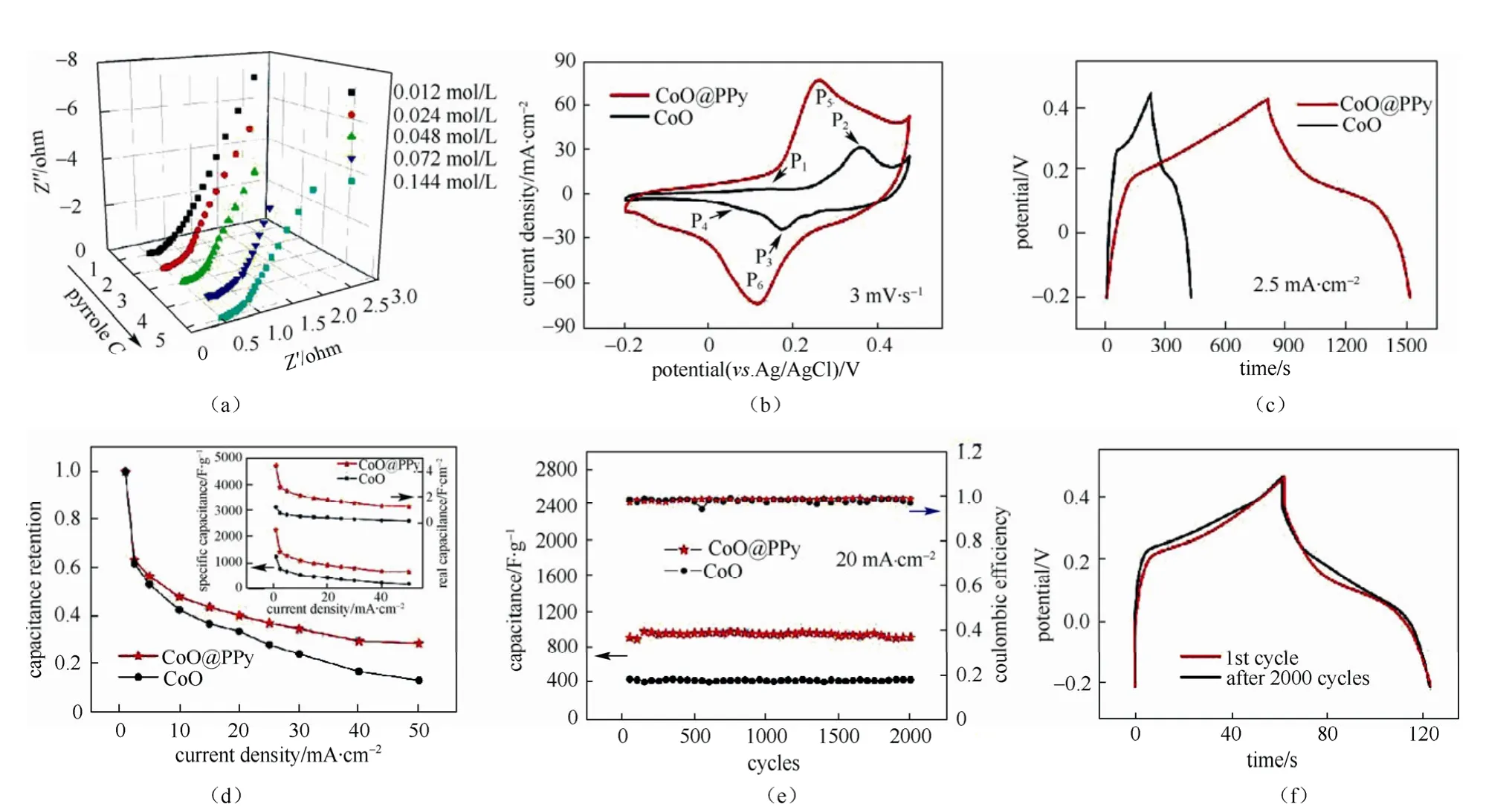
图26 三维CoO/聚吡咯复合材料在3 mol/L KOH溶液中的电化学实验[88] Fig.26 The result of electrochemical experiments of CoO/polypyrrole compoiste[88]
5 展 望
作为一种新兴的储能器件,超级电容器具有极其广阔的市场前景,其性能的显著提高主要取决于高性能电极材料的研究和应用。为了满足电动汽车和可再生能源发电等对超级电容器的高能量/高功率密度的需求,必须使电极材料具有比电容高、电导率高、循环寿命长和成本低等特点[89-96]。对于双电层电容的首选材料碳材料而言,主要研究方向有:① 低成本、高比表面积、高活性的活性炭材料的可控制备;② 廉价、高纯碳纳米管的高效制备;③ 低成本、性能可控的石墨烯的规模化生产等。对于廉价金属氧化物——二氧化锰,如果有效地解决其电导率和循环稳定性差的问题,进一步提高电极材料的利用率,也将有助于实现二氧化锰超级电容器的大规模应用[97-100]。采用复合材料作为超级电容器电极材料,利用所谓“协同效应”,提高材料的综合电化学性能是超级电容器研究的热点。当前,制备高能量密度、高功率密度和低成本的新型复合材料的研究热点包括复合体系的筛选以及新型的纳米复合技术[101-106]。在实现超级电容器的完全实用化的过程中,仍需开发复合材料的新型合成技术以及电极的制备新工艺,从而进一步提高和完善材料的性能和电容器的制备技术,从而提高电容器的实际应用性能。
[1] Wang Kang(王康),Yu Aimei(余爱梅),Zheng Huajun(郑华均).Electrode materials for super-capacitor[J].Zhejiang Chemical Industry(浙江化工),2010,41(4):18-22.
[2] Xiao Chao(肖超),Tang Bin(唐斌),Wu Mengqiang(吴孟强),Zhang Shuren(张树人).Research progress of supercapacitor electrode materials[J].Insulating Materials(绝缘材料),2007,40(1):44-47.
[3] Yuan Lei(袁磊),Wang Zhaoyang(王朝阳),Fu Zhibing(付志兵),Zhang Houqiong(张厚琼),Tang Yongjian(唐永建).Research progress in electrode materials for supercapacitor[J].Materials Review(材料导报),2010,24(9):11-14.
[4] Wang Xingyan(汪形艳),Wang Xianyou(王先友),Huang Weiguo(黄伟国).Research on the electrode materials for supercapacitor[J].Battery(电池),2004,34(3):192-193.
[5] Zhu Xiufeng(朱修锋),Jing Xiaoyan(景晓燕),Zhang Milin(张密林).Progress on metal oxides-based supercapacitors and their applications[J].Journal of Functional Materials and Devices(功能材料与器件学报),2002,8(3):325-330.
[6] Simon P,Gogotsi Y.Materials for electrochemical capacitors[J].Nature Materials,2008,7:845-854.
[7] Frackowiak E.Carbon materials for supercapacitor application[J].Physical Chemistry Chemical Physics,2007,9:1774-1785.
[8] Zha Quanxing(查全性).电极过程动力学导论[M].Beijing:Science Press,2002.
[9] Cheng Xinqun(程新群).化学电源[M].Beijing:Chemical Industry Press,2008.
[10] Yuan Guohui(袁国辉).Electrochemical Capacitor(电化学电容器)[M].Beijing:Chemical Industry Press,2006.
[11] Wu Xuran(吴旭冉),Jia Zhijun(贾志军),Ma Hongyun(马洪运),Liao Sida(廖斯达),Wang Baoguo(王保国).Application of electrochemistry( Ⅱ )——Development and application of electrochemical capacitor[J].Energy Storage Science and Technology(储能科学与技术),2013,2(6):636-641.
[12] Momma T,Liu X J,Osaka T,Ushio Y,Sawada Y.Electrochemical modification of active carbon fiber electrode and its application to double-layer capacitor[J].Journal of Power Sources,1996,60:249-253.
[13] Ma C,Song Y,Shi J L,Zhang D Q,Zhai X L,Zhong M,Guo Q G,Liu L.Preparation and one-step activation of microporous carbon nanofibers for use as supercapacitor electrodes[J].Carbon,2013,51:290-300.
[14] Du X,Zhao W,Wang Y,Wang C Y,Chen M M,Qi T,Hua C.Preparation of activated carbon hollow fibers from ramie at low temperature for electric double-layer capacitor applications[J].Bioresource Technology,2013,149:31-37.
[15] Li Wencui(李文翠),Lu Anhui(陆安慧),GuoShucai(郭树才).Preparation, properties and application of carbon aeroge[J].Carbon Techniques(碳素技术),2001,113:17-20.
[16] Pekala R W.Organic aerogels form the polycondensation of resorcinol with formaldehyde[J].Journal of Materials Science,1989,24:3221-3227.
[17] Pekala R W,Farmer J C,Alviso C T,Tran T D,Mayer S T,Miller J M,Dunn B.Carbon aerogels for electrochemical applications[J].Journal of Non-Crystalline Solids,1998,224:74-80.
[18] Wu D C,Chen X,Lu S H,Liang Y R,Xu F,Fu R W.Study on synergistic effect of ordered mesoporous carbon and carbon aerogel during electrochemical charge-discharge process[J].Microporous and Mesoporous Materials,2013,131:261-264.
[19] Hwang S W,Hyun S H.Capacitance control of carbon aerogel electrodes[J].Journal of Non-Crystalline Solids,2004,347:238-245.
[20] Zhu Z J,Hu Y J,Jiang H,Li C Z.A three-dimensional ordered mesoporous carbon/carbon nanotubes nanocomposites for supercapacitors[J].Journal of Power Sources,2014,247:402-408.
[21] Bose S,Kuila T,Mishra A K,Rajasekar R,Kim N H,Lee J H.Carbon-based nanostructured materials and their composites as supercapacitor electrodes[J].Jouranl of Materials Chemistry,2012,22:767-784.
[22] Aboutalebi S H,Chidembo A T,Salari M,Konstantinov K,Wexler D,Liu H K,Dou S X.Comparison of GO, GO/MWCNTs composite and MWCNTs as potential electrode materials for supercapacitor[J].Energy and Environmental Sciences,2011,4:1855-1865.
[23] Niu Z Q,Zhou W Y,Chen J,Feng G X,Li H,Ma W J,Li J Z,Dong H B,Ren Y,Zhao D,Xie S S.Compact-designed supercapacitors using free-standing single-walled carbon nanotube films[J].Energy and Environmental Sciences,2011,4:1440-1446.
[24] Naoi K,Naoi W,Aoyagi S,Miyamoto J I,Kamino T.New generation “nanohybrid supercapacitor”[J].Accounts of Chemical Research,2013,46(5):1075-1083.
[25] Zhang L L,Zhao X S.Carbon-based materials as supercapacitor electrodes[J].Chem.Soc.Rev.,2009,38:2520-2531.
[26] He Y M,Chen W J,Gao G T,Zhou J Y,Li X D,Xie E Q.An overview of carbon materials for flexible electrochemical capacitors[J].Nanoscale,2013,5:8799-8820.
[27] Hse Y K,Chen Y C,Lin Y G,Chen L C,Chen K H.High-cell-voltage supercapacitor of carbon nanotube/carbon cloth operating in neutral aqueous solution[J].Journal of Materials Chemistry,2012,22:3383-3387.
[28] Zhang C G,Peng Z W,Lin J,Zhu Y,Ruan G D,Hwang C C,Lu W,Hauge R H,Tour J M.Splitting of a vertical multiwalled carbon nanotube carpet to a graphene nanoribbon carpet and its use in superapacitors[J].ACS Nano,2013,7(6):5151-5159.
[29] Chen Q,Meng Y N,Hu C G,Zhao Y,Shao H B,Chen N,Qu L T.MnO2-modified hierarchical graphene fiber electrochemical supercapacitor[J].Journal of Power Sources,2014,247;32-39.
[30] Huang X,Qi X Y,Boey F,Zhang H.Graphene-based composites[J].Chem.Soc.Rev.,2012,41:666-686.
[31] Xu C H,Xu B H,Gu Y,Xiong Z G,Jing Sun J,Zhao X S.Graphene-based electrodes for electrochemical energy storage[J].Energy and Environmental Science,2013,6:1388-1414.
[32] Stoller M D,Park S,Zhu Y W,An J H,Ruoff R S.Graphene-based ultracapacitors[J].Nano Letters,2008,8(10):3498-3502.
[33] Shao Q G,Tang J,Lin Y X,Zhang F F,Yuan J S,Zhang H,Shinya N,Qin L C.Synthesis and characterization of graphene hollow spheres for application in supercapacitors[J].Journal of Materials Chemistry A,2013,1:15423-15428.
[34] Lee J H,Park N,Kim B G,et al.Restacking-inhibited 3D reduced graphene oxide for high performance supercapacitor electrodes[J].ACS Nano,2013,7(10):9366-9374.
[35] Lv Y,Li H Q,Xie Y,et al.Facile synthesis and electrochemical properties of MnO2/carbon nanotubes[J].Particuology,2013,http://dx.doi.org/10.1016/j.partic.2012.12.006
[36] Dubal D P,Dhawale D S,Salunkhe R R,Lokhande C D.A novel chemical synthesis of Mn3O4thin film and its stepwise conversion into birnessite MnO2during super capacitive studies[J].Journal of Electroanalytical Chemistry,2010,647:60-65.
[37] Yu P,Zhang X,Chen Y,Ma Y W.Solution-combustion synthesis of ε-MnO2for supercapacitors[J].Materials Letters,2010,64:61-64.
[38] Wang J G,Yang Y,Huang Z H,Kang F Y.A high-performance asymmetric supercapacitor based on carbon and carbon-MnO2nanofiber electrodes[J].Carbon,2013,61:190-199.
[39] Alhebshi N A,Rakhi R B,Alshareef H N.Conformal coating of Ni(OH)2nanoflakes on carbon fibers by chemical bath deposition for efficient supercapacitor electrodes[J].Journal of Materials Chemistry A,2013,doi:10.1039/c3ta12936e
[40] Chen F,Zhou W J,Yao H F,Fan P,Yang J T,Fei Z D,Zhong M Q.Self-assembly of NiO nanoparticles in lignin-derived mesoporous carbons for supercapacitor applications[J].Green Chemistry,2013,15:3057-3063.
[41] Xing Z C,Chu Q X,Ren X B,et al.Ni3S2coated ZnO array for high-performance supercapacitors[J].Journal of Power Sources,2014,245:463-467.
[42] Huang J C,Xu P P,Cao D X,et al.Asymmetric supercapacitors based on Ni(OH)2nanosheets and activated carbon with high energy density[J].Journal of Power Sources,2014,246:371-376.
[43] Xue T,Lee J M.Capacitive behavior of mesoporous Co(OH)2nanowires[J].Journal of Power Sources,2014,245:194-202.
[44] Yuan C Z,Gao B,Su L H,et al.Interface synthesis of mesoporous MnO2and its electrochemical capacitive behaviors[J].Journal of Colloid and Interface Science,2008,322:545-550.
[45] Wu Z S,Wang D W,Ren W C,et al.Anchoring hydrous RuO2on graphene sheets for high-performance electrochemical capacitors[J].Advanced Functional Materials,2010,20:3595-3602.
[46] Salunkhe R R,Jang K H,Lee S W,Ahn H J.Aligned nickel-cobalt hydroxide nanorod arrays for electrochemical pseudocapacitor application[J].RSC Advances,2012,2:3190-3193.
[47] Tang W,Liu L L,Tian S,et al,Aqueous supercapacitors of high energy density based on MoO3nanoplates as anode material[J].Chemistry Communication,2011,47:10058-10060.
[48] Mondal C,Ganguly M,Manna P K,et al.Fabrication of porous Co(OH)2architecture at room temperature:A high performance supercapacitor[J].Langmuir,2013,29:9179-9187.
[49] He Y M,Chen W J,Li X D,et al.Freestanding three-dimensional graphene/MnO2composite networks as ultralight and flexible supercapacitor electrodes[J].ACS Nano,2013,7(1):174-182.
[50] Shi W H,Zhu J X,Sim D H,et al.Achieving high specific charge capacitances in Fe3O4/reduced graphene oxide nanocomposites[J].Journal of Materials Chemistry,2011,21:3422-3427.
[51] Lee H Y,Goodenough J B.Supercapacitor behavior with KCl electrolyte[J].Journal of Solid State Chemistry,1999,144:220-223.
[52] Zhu G,Deng L J,Wang J F,et al.Hydrothermal preparation and the capacitance of hierarchical MnO2nanoflower[J].Colloids and Surfaces A:Physicochemical and Engineering Aspects,2012,434:42-48.
[53] Zhang L,Xu Y.Jin D,Xie Y.Well-aligned molybdenum oxide nanorods on metal substrates:solution-based synthesis and their electrochemical capacitor application[J].Journal of Materials Chemistry,2010,20:7135-7143.
[54] Liu D Q,Wang X,Wang X B,et al.Ultrathin nanoporous Fe3O4-carbon nanosheets with enhanced supercapacitor performance[J].Journal of Materials Chemistry A,2013,1:1952-1955.
[55] Ji J Y,Zhang L L,Ji H M,et al.Nanoporous Ni(OH)2thin film on 3D ultrathin-graphite foam for asymmetric supercapacitor[J].ACS Nano,2013,7(7):6237-6243.
[56] Lu X H,Huang X,Xie S L,et al.Controllable synthesis of porous nickel-cobalt oxide nanosheets for supercapacitor[J].Journal of Materials Chemistry,2012,22:13357-13364.
[57] Xu K B,Zou R J,Li W Y,et al.Self-assembling hybrid NiO/Co3O4ultrathin and mesoporous nanosheets into flower-like architechtures for supercapacitor[J].Journal of Materials Chemistry A,2013,1:9107-9113.
[58] Liang K,Tang X Z,Hu W C.High-performance three-dimensional nanoporous NiO film as a supercapacitor elect[J].Journal of Materials Chemistry,2012,22:11062-11067.
[59] Li J T,Zhao W,Huang F Q,et al.Single-crystalline Ni(OH)2and NiO nanoplatelet arrays as supercapacitor electrodes[J].Nanoscale,2011,3:5103-5109.
[60] Singh Ashutosh K,Sarkar Debasish,Khan Gobinda Gopal,et al.Unique hydrogenated Ni/NiO core/shell 1D nano-heterostructures with superior electrochemical performances as supercapacitors[J].Journal of Materials Chemistry A,2013,1:12759-12767.
[61] Ghenaatian H R,Mousavi M F,Rahmanifar M S.High performance hybrid supercapacitor based on two nanostructured conducting polymers:Self-dopped polyaniline and polypyrrole nanofibers[J].Electrochimica Acta,2012,78:212-222.
[62] Dhawale D S,Vinu A,Lokhande C D.Stable nanostructured polyaniline electrode for supercapacitor application[J].Electrochimica Acta,2011,56:9482-9487.
[63] Dhawale D S,Dubal D P,Jamadade V S,et al.Fuzzy nanofibrous network of polyaniline electrode for supercapacitor application[J].Synthetic Metals,2010,160:519-522.
[64] Zhao X,Johnston C,Grant P S.A noval hybrid supercapacitor with a carbon nanotube cathode and an iron oxide/carbon nanotube composite anode[J].Journal of Materials Chemistry,2009,19:8755-8760.
[65] Chen S,Zhu J W,Zhou H,Wang X.One-step synthesis of low defect density carbon nanotube-doped Ni(OH)2nanosheets with improved electrochemical performances[J].RSC Advances,2011,1:484-489.
[66] Salunkhe R R,Jang K,Lee S W,et al.Binary metal hydroxide nanorods and multi-walled carbon nanotube composites for electrochemical energy storage applications[J].Journal of Materials Chemistry,2012,22:21630-21635.
[67] Lei Z B,Shi F H,Lu L.Incorporation of MnO2-coated carbon nanotubes between graphene sheets as supercapacitor electrode[J].ACS Applied Materials & Interfaces,2012,4:1058-1064.
[68] Reddy A L M,Shaijumon M M,Gowda S R,Ajayan P M.Multisegmented Au-MnO2/carbon nanotube hybrid coaxial arrays for high-power supercapacitor applications[J].Journal of Physical Chemistry C,2010,114:658-663.
[69] Reddy A L M,Ramaprabhu S.Nanocrystalline metal oxides dispersed multiwalled carbon nanotubes as supercapacitor electrodes[J].Journal of Physical Chemistry C,2007,111:7727-7734.
[70] Wang X,Han X D,Lim M F,et al.Nickel cobalt oxide-single wall carbon nanotube composite material for superior cycling stability and high-performance supercapacitor application[J].The Journal of Physical Chemistry C,2012,116:12448-12454.
[71] Lee J W,Hall A S,Kim J D,Mallouk T E.A facile and template-free hydrothermal synthesis of Mn3O4nanorods on graphene sheets for supercapacitor electrodes with long cycle stability[J].Chemistry of Materials,2012,24:1158-1164.
[72] Ghosh D,Giri S,Das C K.Preparation of CTAB-assisted hexagonal platelet Co(OH)2/graphene hybrid composite as efficient supercapacitor electrode material[J].ACS Sustainable Chemistry and Engineering,2013,1:1135-1142.
[73] Li Z P,Wang J Q,Niu L Y,et al.Rapid synthesis of graphene/cobalt hydroxide composite with enhanced electrochemical performance for supercapacitors[J].Journal of Power Sources,2014,245:224-231.
[74] Wang Q H,Jiao L F,Du H M,et al.Fe3O4nanoparticles grown on graphene as advanced electrode materials for supercapacitors[J].Journal of Power Sources,2014,245:101-106.
[75] Xiao Y H,Cao Y B,Gong Y Y,et al.Electrolyte and composition effects on the performances of asymmetric supercapacitors constructed with Mn3O4nanoparticles-graphene nanocomposites[J].Journal of Power Sources,2014,246:926-933.
[76] Dong X C,Xu H,Wang X W,Huang Y X,et al.3D graphene-cobalt oxide electrode for high-performances supercapacitor and enzymeless glucose detection[J].ACS Nano,2012,6(4):3206-3213.
[77] Li Z P,Mi Y J,Liu X H,et al.Flexible graphene/MnO2composite papers for supercapacitor electrodes[J].Journal of Materials Chemistry,2011,21:14706-14711.
[78] Huang S,Zhu G N,Zhang C,et al.Immobilization of Co-Al layered double hydroxides on graphene oxide nanosheets:growth mechanism and supercapacitor studies[J].Applied Materials & Interfaces,2012,4:2242-2249.
[79] Zhang H T,Zhang X,Zhang D C,et al.One-step electrophoretic deposition of reduced graphene oxide and Ni(OH)2composite films for controlled syntheses supercapacitor electrodes[J].The Journal of Physical Chemistry B,2013,117:1616-1627.
[80] Wang B,Park J,Su D W,et al.Solvothermal synthesis of CoS2-graphene nanocomposite material for high-performanc supercapacitors[J].Journal of Materials Chemistry,2012,22:15750-15756.
[81] Li F H,Song J F,Yang H F,et al.One-step synthesis of graphene/SnO2nanocomposites and its application in electrochemical supercapacitors[J].Nanotechnology,2009,20:455602.
[82] Li B J,Cao H Q.ZnO@graphene composite with enhanced performance for the removal of dye from water[J].Journal of Materials Chemistry,2011,21:3346-3349.
[83] Wu Z S,Wang D W,Ren W C,et al.Anchoring hydrous RuO2on graphene sheets for high-performance electrochemical capacitors[J].Advanced Functional Materials,2010,20:3595-3602.
[84] Zhu Y G,Cao G S,Sun C Y,et al.Design and synthesis of NiO nanoflakes/graphene nanocomposites as high performance electrodes of pseudocapacitor[J].RSC Advances,2013,3:19409-19415.
[85] Ge J,Cheng G H,Chen L W.Transparent and flexible electrodes and supercapacitors using polyaniline/single-walled carbon nanotube composite thin films[J].Nanoscale,2011,3:3084-3088.
[86] Liu H L,Wang Y ,Gou X L ,et al.Three-dimensional graphene/polyaniline composite material for high-performance supercapacitor applications[J].Materials Science and Engineering B,2013,178:293-298.
[87] Sumboja A,Foo C Y,Yan J,et al.Significant electrochemical stability of manganese dioxide/polyaniline coaxial nanowires by self-terminated double surfactant polymerization for pseudocapacitor electrode[J].Journal of Materials Chemistry,2012,22:23921-23928.
[88] Zhou C,Zhang Y W,Li Y Y,Liu J P.Construction of high-capacitance 3D CoO@polypyrrole nanowire array electrode for aqueous asymmetric supercapacitor[J].Nano Letters,2013,13:2078-2085.
[89] Kim J Y,Lee S H,Yan Y F,et al.Controlled synthesis of aligned Ni-NiO core-shell nanowire arrays on glass substrates as a new supercapacitor electrode[J].RSC Advances,2012,2:8281-8285.
[90] Huang Y,Li Y Y,Hu Z Q,et al.A carbon modified MnO2nanosheet array as a stable high-capacitance supercapacitor electrode[J].Journal of Materials Chemistry A,2013,1:9809-9813.
[91] Zhang Q L,Zhang Y W,Gao Z H,et al.A facile synthesis of platinum nanoparticle decorated graphene by one step γ-ray induced reduction for high rate supercapacitor[J].Journal of Materials Chemistry C,2013,1:321-328.
[92] Lin Y Y,Yeh M H,Tsai J T,et al.A novel core-shell multi-walled carbon nanotube@graphene oxide nanoribbon heterostructure as a potential supercapacitor material[J].Journal of Materials Chemistry A,2013,1:11237-11245.
[93] Zhao X,Johnston C,Grant P S.A novel hybrid supercapacitor with a carbon nanotube cathode and an iron oxide/carbon nanotube composite anode[J].Journal of Materials Chemistry,2009,19:8755-8760.
[94] Jost K,Perez C R,McDonough J K,et al.Carbon coated textiles for flexible energy storage[J].Energy and Environmental Science,2011,4:5060-5067.
[95] Wang Y,Shi Z Q,Huang Y,et al.Supercapacitor devices based on graphene materials[J].Journal of Physical Chemistry C,2009,113:13102-13107.
[96] Kim M S,Carraro C,Carraro C,et al.Cycling characteristics of high energy density,electrochemically activated porous-carbon supercapacitor electrodes in aqueous electrolytes[J].Journal of Materials Chemistry A,2013,1:10518-10523.
[97] Niu Z Q,Luan P S,Shao Q,et al.A “skeleton/skin” strategy for preparing ultrathin free-standing single-walled carbon nanotube/polyaniline films for high performance supercapacitor electrodes[J].Energy& Environmental Science,2012,5:8726-8733.
[98] Jiang H,Lee P S,Li C Z.3D carbon based nanostructures for advanced supercapacitors[J].Energy&Environmental Science,2013,6:641-653.
[99] Zhang J T,Jiang J W,Li H L,Zhao X S.A high-performance asymmetric supercapacitor fabricated with graphene-based electrodes[J].Energy & Environmental Science,2011,4:4009-4015.
[100] Lin L Y,Yeh M H,Tsai J T,et al.A novel core-shell multi-walled carbon nanotube@graphene oxide nanoribbon heterostructure as a potential supercapacitor material[J].Journal of Materials Chemistry A,2013,1:11237-11245.
[101] Liu X H,Zhou L,Zhao Y Q,et al.Hollow,spherical nitrogen-rich porous carbon shells obtained from a porous organic framework for the supercapacitor[J].Applied Materials & Interfaces,2013,5:10280-10287.
[102] Dennison C R,Beidaghi M,Hatzell K B,et al.Effects of flow cell design on charge percolation and storage in the carbon slurry electrodes of electrochemical flow capacitors[J].Journal of Power Sources,2014,247:489-496.
[103] Yun Y S,Lee M E,Joo M J,Jin H J.High-performance supercapacitors based on freestanding carbon-based composite paper electrodes[J].Journal of Power Sources,2014,246:540-547.
[104] Duong B,Yu Z N,Gangopadhyay P,et al.High throughput printing of nanostructured carbon electrodes for supercapacitors[J].Advanced Materials,2013,doi:10.1002/admi.201300014.
[105] Tamilarasan P,Rammaprabhu S.Graphene based all-solid-state supercapacitors with ionic liquid incorporated polyacrylonitrile electrolye[J].Energy,2013,51:374-381.
[106] Yuan L Y,Lu X H,Xiao X,et al.Flexible solid-state supercapacitors based on carbon nanoparticles/MnO2nanorods hybrid structures[J].ACS Nano,2012,6(1):656-661.

